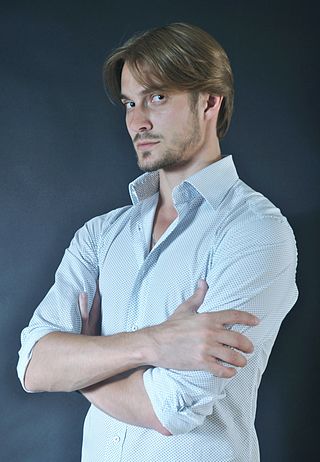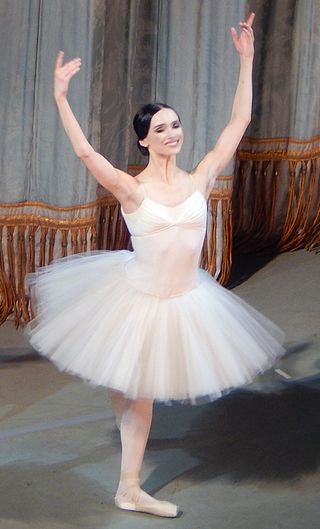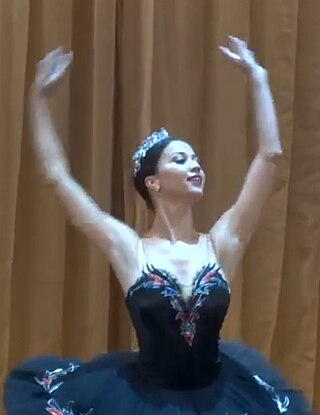Related Research Articles
This is a list of music-related events in 1818.
The Mariinsky Ballet is the resident classical ballet company of the Mariinsky Theatre in Saint Petersburg, Russia.

The Piano Sonata No. 29 in B♭ major, Op. 106 by Ludwig van Beethoven was composed in 1817 and published in 1818. The sonata is widely viewed as one of the most important works of the composer's third period, a pivotal work between his third and late period, and among the greatest piano sonatas of all time. It is also considered to be Beethoven's most technically challenging piano composition and one of the most demanding solo works in the classical piano repertoire. The first documented public performance was in 1836 by Franz Liszt in the Salle Erard in Paris to an enthusiastic review by Hector Berlioz.

Beethoven's Piano Sonata No. 21 in C major, Op. 53, known as the Waldstein, is one of the three most notable sonatas of his middle period. Completed in summer 1804 and surpassing Beethoven's previous piano sonatas in its scope, the Waldstein is a key early work of Beethoven's "Heroic" decade (1803–1812) and set a standard for piano composition in the grand manner.

Nederlands Dans Theater is a Dutch contemporary dance company. NDT is headquartered at the Amare building in The Hague. NDT also performs at other venues in the Netherlands, including Amsterdam's Het Muziektheater and Nijmegen's Stadsschouwburg. NDT comprises three dance companies: Nederland Dans Theater I, Nederland Dans Theater II, and Nederland Dans Theater III.

Hans Arthur Gerard van Manen is a Dutch ballet dancer, choreographer and photographer.
Altin Kaftira is a former danseur with the Dutch National Ballet in Amsterdam, Netherlands. He danced with the Ballet from 1995 on, and from 2000 to 2007 was the Ballet's principal dancer, and has danced in almost a dozen George Balanchine ballets. In 2007, he left to pursue a career as a filmmaker. One of his first film assignments was the production and direction of the 75th anniversary gala for Hans van Manen.
Fernanda Oliveira is a Brazilian ballet dancer. She is a lead principal with English National Ballet.
Ekaterina Kondaurova is a Russian ballet dancer, currently one of the stars of the Mariinsky Ballet from Saint Petersburg. She is a Merited Artist of the Russian Federation as of 2020.

Vienna State Ballet, Wiener Staatsballett, is considered one of the world's top ballet companies. It was formerly named the Vienna State Opera Ballet as it is based at the Vienna State Opera building. In 2005 the ballets of the Vienna State Opera and the Vienna Volksoper were merged under the name Das Ballett der Wiener Staatsoper und Volksoper and Gyula Harangozo became the artistic director. On 1 September 2010, a further name change was accompanied by a change in leadership. Manuel Legris, former principal dancer with the Paris Opera Ballet, succeeded as the artistic director.

The Vertiginous Thrill of Exactitude is a ballet choreographed by William Forsythe to the finale of Schubert's Symphony No. 9. The ballet was choreographed for Frankfurt Ballet's programme Six Counter Points, and was presented as a ballet "in the Manner of the late 20th Century." Danced by a cast of five, the ballet features classical and technically demanding choreography. It premiered on 20 January 1996, at Frankfurt. It had since been performed by many other ballet companies.

Olga Vyacheslavovna Smirnova is a Russian ballet dancer. Formerly a prima ballerina of the Bolshoi Ballet, she is currently a prima ballerina with the Dutch National Ballet in Amsterdam, Netherlands. She has danced at venues across Europe, as well as appearing in Beijing, China and Japan.

Viktoria Valerievna Tereshkina is a Russian ballet dancer, who performs as a principal dancer with the Mariinsky Ballet in Saint Petersburg. People's Artist of Russia (2018). Laureate of the highest theater award of St. Petersburg "Golden Soffit", and Laureate of the IX International Ballet Competition "Arabesque".

Artem Nikolayevich Yachmennikov is a ballet artist, soloist and premier at leading theaters, including the Bolshoi Theatre and Mariinsky Theatre.

Krzysztof Pastor is a Polish dancer, choreographer and ballet director. He was resident choreographer with the Dutch National Ballet in Amsterdam from 2003 to 2017, director of the Polish National Ballet in Teatr Wielki – Polish National Opera in Warsaw since 2009 and at the same time from 2011 until 2020 was the artistic director of the ballet of the Lithuanian National Opera and Ballet Theatre in Vilnius.

Olesya Novikova is a Russian ballet dancer. She is a principal dancer with the Mariinsky Theatre.

Renata Mukhametovna Shakirova is a ballet dancer, currently a principal with the Mariinsky Ballet.
The Dutch National Ballet Academy of Amsterdam (NBA) is the premier school for classical ballet in the Netherlands. Young talented dancers receive a ballet education at the highest level. The NBA brings ballet dancers up to the professional standard that is required by top international ballet companies, such as the Dutch National Ballet.
Anna Ol is a Russian ballet dancer. She is a principal dancer in the Dutch National Ballet.
Monique Sand is a French ballet dancer, best known for her work as a principal dancer with the Dutch National Ballet from 1971 to 1982.
References
- 1 2 3 4 5 6 Anderson, Zoë (29 May 2015). The Ballet Lover's Companion. p. 248-249. ISBN 978-0-300-15429-0.
- ↑ Dowler, Gerald (15 September 2016). "Dutch Masters, Dutch National Ballet, Stopera, Amsterdam — review". Financial Times.
- 1 2 Craine, Debra; Mackrell, Judith (19 August 2010). The Oxford Dictionary of Dance. p. 3. ISBN 978-0-19-956344-9.
- ↑ Chapelle, Laura (17 June 2014). "Hans Van Manen programme, Mariinsky II, St Petersburg – review". Financial Times.
- ↑ Ward, Rachel (25 March 2017). "English National Ballet: a thrilling, pulsing dance on the wild side – Pina Bausch/Forsythe/Van Manen, review". The Telegraph.
- ↑ Zerbst, Rainer (7 April 2021). "Triumphe mit Ludwig van: Beethoven-Ballette am Stuttgarter Ballett". Bachtrack (in German).
- ↑ "Review: Enthralling programme of 5 works by Hans van Manen and Roland Petit at La Scala". Gramilano. 24 February 2020.
- ↑ Kisselgoff, Anna (14 March 1975). "The Dance: Pennsylvania Ballet Here". New York Times.
- ↑ Winship, Lyndsey (10 September 2023). "Northern Ballet: Generations review – Tiler Peck premieres an intricate work of lyrical yearning". The Guardian.